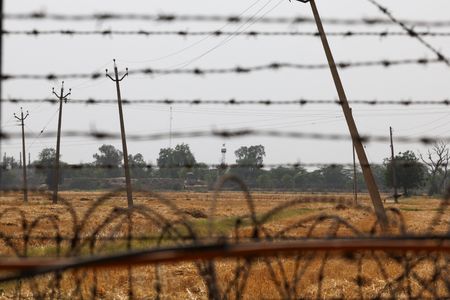By Tom Bateman and Rocky Swift
KIMITSU, Japan (Reuters) -With his black uniform jacket slung rakishly over his shoulders and his feet propped up on a Japanese school desk as he held court with his crew, Jason Wu was taking great satisfaction in being a juvenile delinquent.
The 29-year-old New Yorker was participating in a one-day mock school experience at “Kimino High School” for foreign tourists in Japan. It’s designed to appeal to anime fans like Wu and his wife as well as those simply curious about cultural differences in education.
At a repurposed school about 60 km (37 miles) southeast of Tokyo, participants pay about 35,000 yen ($245) to dress in classic Japanese school uniforms and attend calligraphy and other lessons. In gym class, they play traditional Japanese sports day group competitions like tug-of-war or throwing bean bags high into a net basket.
Like Japanese school children, they also practice earthquake drills, serve lunch and clean the classroom at the end of the day.
“This is like the only experience that you can do to have some semblance of the Japanese high school life,” said Wu, a software engineer.
Amid a tourism boom fuelled by an extremely weak yen, repeat visitors to Japan like Wu, who is on his 10th trip here, are looking for more immersive activities.
The classroom experience, organised by event planning company Undokai, also dovetails with a government plan to coax more visitors outside of destinations like Tokyo and Kyoto suffering from “overtourism” and into rural areas.
Many manga or anime such as supernatural drama “Jujutsu Kaisen” and romantic comedy “Ouran High School Host Club”, both of which have aired on Netflix, are set in high schools and for anime fans in particular, getting to experience high school is a peak Japanese experience.
“Lots of animes will feature school life being this ideal part of your childhood,” said Wu’s wife, Parina Kaewkrajang, 27.
“It’s a type of nostalgia that we wanted to experience for ourselves.”
Formerly known as Kameyama Middle School, the event’s name Kimino is a play on words for “your” high school and the name of the town Kimitsu, known for strawberries and hot springs.
The school closed in 2020 due to a lack of students – an increasingly common occurrence as Japan rapidly ages and the number of children declines. Nearly 6,500 schools across the country have closed in the past two decades, according to government data.
“If this becomes an example of how to utilise closed schools, or attracts attention as a new way to revitalise the local area, I would definitely like to expand it to other places,” said Undokai founder Takaaki Yoneji.
($1 = 143.7600 yen)
(Reporting by Tom Bateman and Rocky Swift; Editing by Edwina Gibbs)













